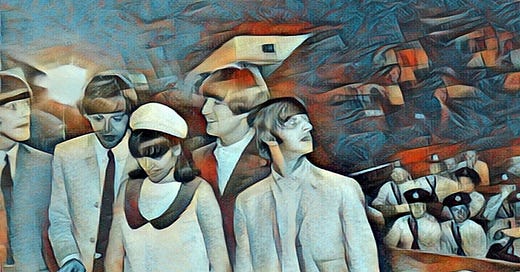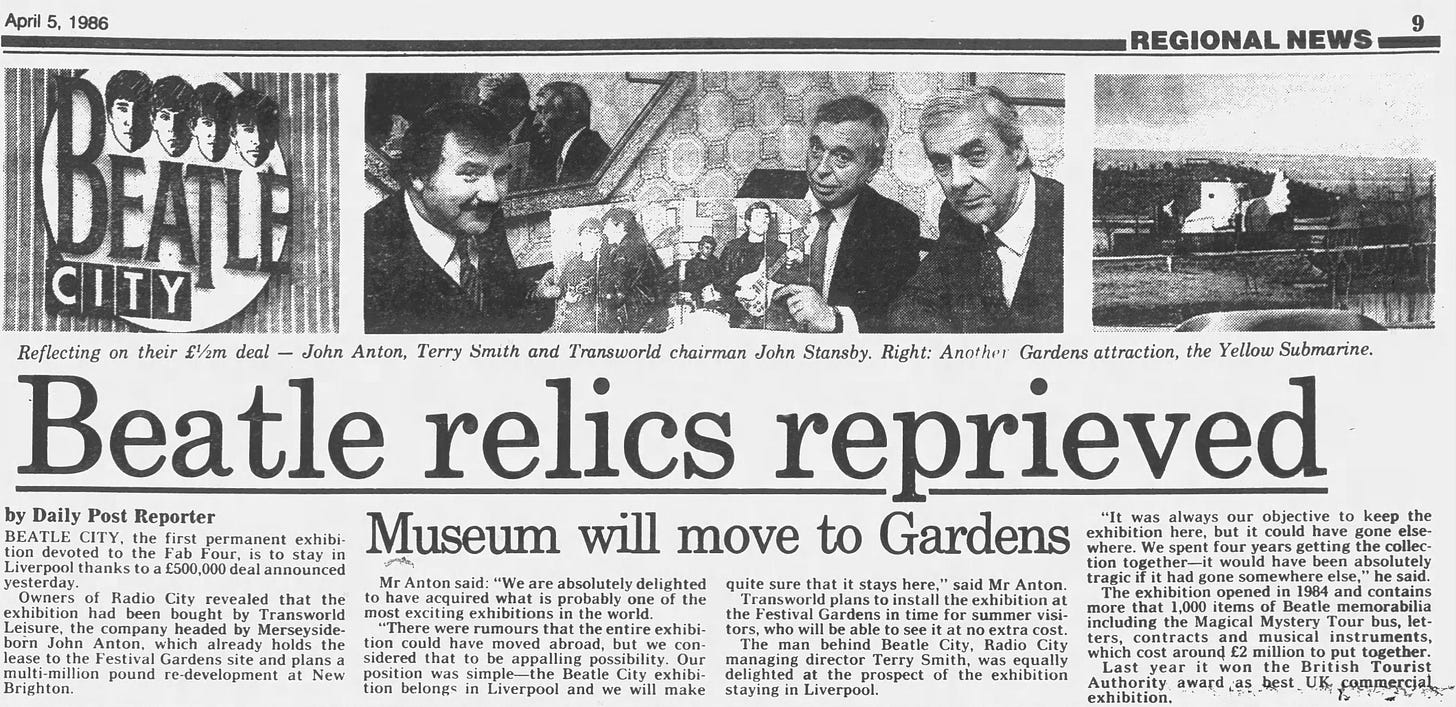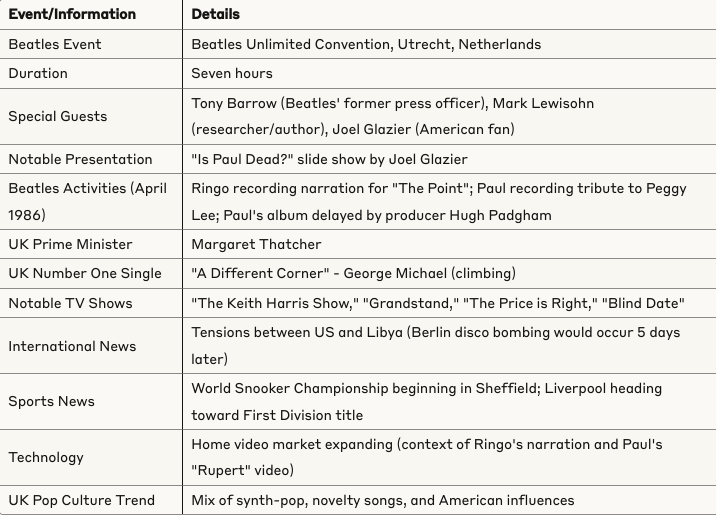There we were, the scattered remnants of the dream, assembled in a Dutch concert hall like pilgrims at a holy site. Utrecht, Netherlands. Saturday, April 5th, 1986. The Beatles had been dead as a unit for sixteen years, yet their ghost—that magnificent spectre—continued to haunt us all, manifesting this time in the form of Beatles Unlimited's annual convention.
Strawberry Fields Forever: The Dutch Convention
The Muziekcentrum Vredenburg in Utrecht—a brutalist concrete temple to sound—played host to hundreds of the faithful, all gathered for a seven-hour celebration of four lads who had stopped playing together before some of the attendees were even born. Seven hours! That's longer than all three "Anthology" collections played back-to-back, longer than the entire "White Album" performed twice through with tea breaks. Seven hours to dissect, analyse, and worship at the altar of Beatledom.
The Dutch have always been an industrious lot. While Britain was still nursing its post-Beatles hangover and America was busy commodifying the memory, those clever continentals were organising themselves. Beatles Unlimited wasn't just any fan club; it was a machine of efficiency, dedication, and the kind of obsessive detail that would make Brian Epstein's meticulous ledgers look like doodles on a napkin.
The Beatles fan club conventions began sprouting up like mushrooms after a rain once the group disbanded. Liverpool's annual Mathew Street Festival would later become the granddaddy of them all, but in 1986, it was these continental gatherings that kept the flame burning brightest. The Chicago Beatlefest in America had been going strong, but there was something particularly poignant about European celebrations—perhaps because they retained something of the original hysteria that greeted the band when they first conquered the continent in '63.
Today's lineup of speakers read like a who's-who of Beatle intelligentsia. Tony Barrow—the man who coined the phrase "The Fab Four" and served as the group's press officer during the height of Beatlemania—was there, no doubt embellishing tales he'd already told a thousand times, each iteration growing more colourful than the last.
Mark Lewisohn, still in the early phase of establishing himself as the Beatles' supreme chronicler, was flogging his new book "The Beatles Live!"—a meticulously researched account of their concert years. In 1986, nobody could have guessed this earnest young researcher would go on to become the Herodotus of Beatleology, eventually embarking on a three-volume biography so detailed it would make the Encyclopedia Britannica seem like a pamphlet.
But the pièce de résistance, the main attraction that surely had the Dutch faithful quivering with anticipation, was American Joel Glazier and his slide show titled "Is Paul Dead?" Yes, that hoary old conspiracy theory that had gained traction in 1969 was being resurrected for a new audience. Glazier's presentation—described in promotional materials as "bizarre, yet fascinating"—no doubt featured all the classic "clues": the bare feet on Abbey Road, the "I buried Paul" whisper in "Strawberry Fields Forever," and the supposed funeral procession on the Sgt. Pepper cover.
The irony, of course, was that as Glazier was busy convincing an audience that McCartney had died in a 1966 car crash, the supposedly deceased Beatle was very much alive in England, recording a spoken tribute to Peggy Lee and fretting about the delay of his new album.
While My Guitar Gently Weeps: Beatles Doings in April '86
April 1986 found the ex-Beatles scattered like seeds in the wind, each busy with projects that almost certainly paled in comparison to their collective past glories.
Ringo Starr, he of the steady beat and nasal Liverpudlian charm, was across the pond in America, lending his distinctive voice to a re-release of Harry Nilsson's animated film "The Point." The original 1971 narration by Dustin Hoffman had been tangled in the barbed wire of contractual disputes, so Ringo stepped in to guide viewers through Nilsson's fable about a round-headed boy in a land of pointed heads. How fitting that the most good-natured Beatle should narrate a tale about accepting differences. One can easily imagine Ringo in the recording booth, his ringed fingers tapping gently on his knee as he intoned the story of little Oblio and his dog Arrow.
Meanwhile, Paul McCartney was engaged in that most dreadful of post-Beatles activities: waiting. His new album was on hold while producer Hugh Padgham finished with Genesis—yes, the same Genesis that had Phil Collins at the helm, the same Phil Collins whose "Su-Su-Sudio" had recently assaulted the world's eardrums. The thought of McCartney, the man who gave us "Yesterday" and "Hey Jude," cooling his heels while Padgham fiddled with the knobs on a Genesis record is enough to make one weep into one's Earl Grey.
The delay was just another indignity in McCartney's increasingly desperate attempts to remain relevant in the synthesizer-soaked wasteland of mid-'80s pop. His previous album, "Press to Play," would be released later that year to a resounding "meh" from critics and public alike. The man who once commanded the attention of the entire planet was now just another ageing rocker fighting for radio play alongside Whitney Houston and Pet Shop Boys.
And then there was the curious case of "Oriental Nightfish"—a song composed by Linda McCartney for the unreleased (and likely unremarkable) album "Wide Prairie." The animated version, featured on the "Rupert And The Frog Song" home video, had caused a minor scandal due to its brief depiction of a naked cartoon woman. The London Borough of Ilford had taken legal action against Virgin Video after a mother's complaint. One can only imagine Paul's reaction: the same man who had battled governments over marijuana possession and slaughter of harp seals was now caught in a controversy over an animated nipple. The '80s were indeed strange times.
As for George Harrison and John Lennon—well, Harrison was likely tending to his gardens at Friar Park, having not released an album since "Gone Troppo" in 1982, while Lennon, of course, remained stubbornly, tragically dead. The bullet that had torn through him outside the Dakota in December 1980 had ensured that the Beatles reunion everyone secretly hoped for would forever remain an impossible dream.
Good Day Sunshine: The World Around on April 5th, 1986
The headlines in British newspapers on this spring Saturday painted a picture of a nation in transition. Margaret Thatcher was still firmly installed at Number 10, her iron grip on the country showing no signs of loosening. The miners had been defeated, the unions were on the back foot, and the City of London was preparing for its "Big Bang" deregulation later that year.
Sports pages were dominated by snooker, with the Embassy World Championship at the Crucible Theatre in Sheffield getting underway. Steve Davis, the ginger-haired potting machine, was favoured to claim yet another title. Football was in its dying days of the season, with Liverpool looking likely to secure another First Division title.
On the international front, the shadow of American-Libyan tensions loomed large. Just five days after the convention, on April 10th, a bomb would explode in a West Berlin discotheque frequented by American servicemen, leading President Reagan to order airstrikes on Libya in retaliation. The Cold War might have been thawing, but new conflicts were already simmering to take its place.
The charts that week reflected the peculiar musical taste of Britain in the mid-'80s—a confused melange of styles that proved the country was still suffering from a post-punk hangover while simultaneously embracing the new technologies of the decade.
George Michael's "A Different Corner" was climbing toward number one, its sleek production and earnest emotion a far cry from the Beatlemania that had gripped the nation two decades earlier. Diana Ross was in the charts with "Chain Reaction," while Falco's "Rock Me Amadeus" was bringing Austrian rap to the masses, proving that truly, anything was possible in the '80s.
The UK Top 10 was rounded out by peculiar novelties like Doctor and the Medics' cover of "Spirit in the Sky" and the europop stylings of Modern Talking's "Brother Louie." One can only imagine what Lennon, had he lived, would have made of such fare—the man who had sneered at "muzak" would likely have had choice words for the sanitised sounds dominating the airwaves.
Radio 1 DJs like Simon Bates, with his "Our Tune" segment, and Steve Wright in the Afternoon would have been spinning these hits with enthusiasm that belied their questionable quality. Over on the rapidly ageing Radio Luxembourg, now fighting a losing battle against the BBC's dominance, similar playlists would have been punctuated by increasingly desperate advertising.
Television that Saturday offered its usual mixed bag. BBC1 presented "The Keith Harris Show" featuring the ventriloquist and his puppet Orville the Duck, while sports fans could enjoy "Grandstand" with its smorgasbord of racing, football results, and whatever minor sports could be crammed into the schedule.
Later that evening, viewers might settle in for "The Price is Right" with Leslie Crowther asking contestants to "come on down," or perhaps "Blind Date" with the irrepressible Cilla Black—herself a product of the Liverpool scene that had given birth to the Beatles—playing matchmaker to the nation's singles.
Those with more discerning tastes might have tuned into Channel 4 for one of its boundary-pushing documentaries or avant-garde films. The channel, still relatively new having launched in 1982, was carving out a niche as the intellectual alternative to the mainstream offerings of BBC and ITV.
A Hard Day's Night: Fan Conventions as Beatle Surrogates
What drove hundreds of Dutch Beatles enthusiasts to spend their Saturday inside a concert hall, listening to three men talk about four other men who hadn't been in the same room together since 1969? The same force, perhaps, that drove thousands to queue for hours outside venues in '63, '64, and '65—that mysterious alchemy the Beatles created, a combination of music, personality, and cultural revolution that has never been fully replicated.
The Beatles Unlimited convention was more than just a gathering of nostalgists; it was a testament to the enduring power of the group's cultural impact. In 1986, with New Wave fading and the spectre of hair metal rising on the horizon, the Beatles remained a fixed point in the cultural firmament—a reminder of a time when popular music seemed capable of changing the world, not just filling dance floors.
For seven hours in Utrecht, the faithful could pretend that it was still possible to capture that magic, to bottle it and take it home. They could trade rare Japanese pressings of "Revolver," debate whether "Revolution 9" was avant-garde genius or indulgent nonsense, and feel part of something larger than themselves. In the process, perhaps they could forget, just for a moment, that Paul was promoting animated frogs, Ringo was replacing Dustin Hoffman, George was gardening, and John was gone forever.
As the convention wound down and the attendees spilled out into the Utrecht evening, clutching their newly purchased memorabilia and signed copies of Lewisohn's book, they carried with them fragments of a dream that had ended long ago but somehow refused to die. Tomorrow they would return to jobs and families and the mundane realities of Dutch life in the mid-'80s, but for today, they had been part of the everlasting echo of the biggest bang in pop music history.
And somewhere in England, Paul McCartney—very much alive despite what Joel Glazier might have suggested—was probably having a vegetarian dinner with Linda, blissfully unaware that across the North Sea, his death was being discussed in exquisite, speculative detail.







the "funeral procession" was on abbey road, as well. john as the priest, ringo as the grief-striken, and george as the grave digger. smh. i am begging you to do research. ANY research at this point.